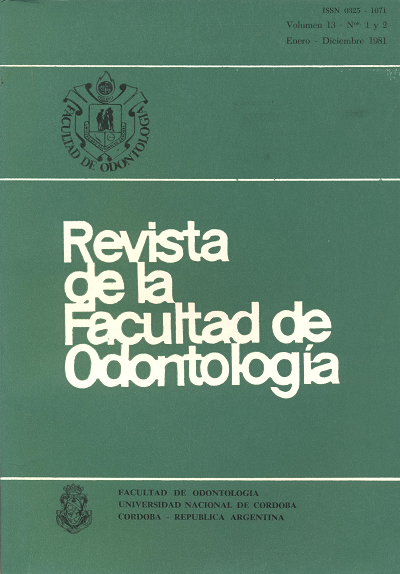Formation of plaque in vitro by Gandida Albicans and Chlorhexidina a ction
Keywords:
In Vitro Techniques, Candida albicans, ChlorhexidineAbstract
The :Presence of Candida Albicans in bacteria! plaques taken from the vestibular and lingual faces of the · upper aud ·lower molars was investigated in a group of students from the School of Dentistry ranging from 18 to 24 years of age. Candida Albicans was found in the 21,14% of the cases studied.
The ez.:perience that is composed of two parts was perforned starting from thease strains: the formation of plaque "in vitro" was investigated during the fust part of the experienée. It w'as cultivated in a base rned~um adding carbohydrates, namely, glucose, saccharose, lactose, starch and rrialtose obtaining plaques formation with different gradations in quantity and adherence according to sugars. Starting from these results the second part of the experience was initiated. It consisted in the aggregate of different concentrations of chlorhexidine to the culture medium to be used .. Inbibition of plaque in vitro was proved in concentrations 6f up to 0,15% in sorne strains. From tbis we could determine that: 1) tbis' microorganism is_ found in bacteria] plaques in a relevant percentage of cases (21,14% ). 2) Gandida Albicans forms plaque in vitro starting from carbohydrates; 3) antiplaque substances like Ghiorhexidine can inhibit thet Cj.eveloprnent of Gandida Albicans in concentrations superior to 0,2%.
Downloads
Downloads
Published
Issue
Section
License
Aquellos autores/as que tengan publicaciones con esta revista, aceptan los términos siguientes:
- Los autores/as conservarán sus derechos de autor y garantizarán a la revista el derecho de primera publicación de su obra, el cuál estará simultáneamente sujeto a la Licencia de reconocimiento de Creative Commons que permite a terceros:
- Compartir — copiar y redistribuir el material en cualquier medio o formato
- La licenciante no puede revocar estas libertades en tanto usted siga los términos de la licencia
- Los autores/as podrán adoptar otros acuerdos de licencia no exclusiva de distribución de la versión de la obra publicada (p. ej.: depositarla en un archivo telemático institucional o publicarla en un volumen monográfico) siempre que se indique la publicación inicial en esta revista.
- Se permite y recomienda a los autores/as difundir su obra a través de Internet (p. ej.: en archivos telemáticos institucionales o en su página web) después del su publicación en la revista, lo cual puede producir intercambios interesantes y aumentar las citas de la obra publicada. (Véase El efecto del acceso abierto).

